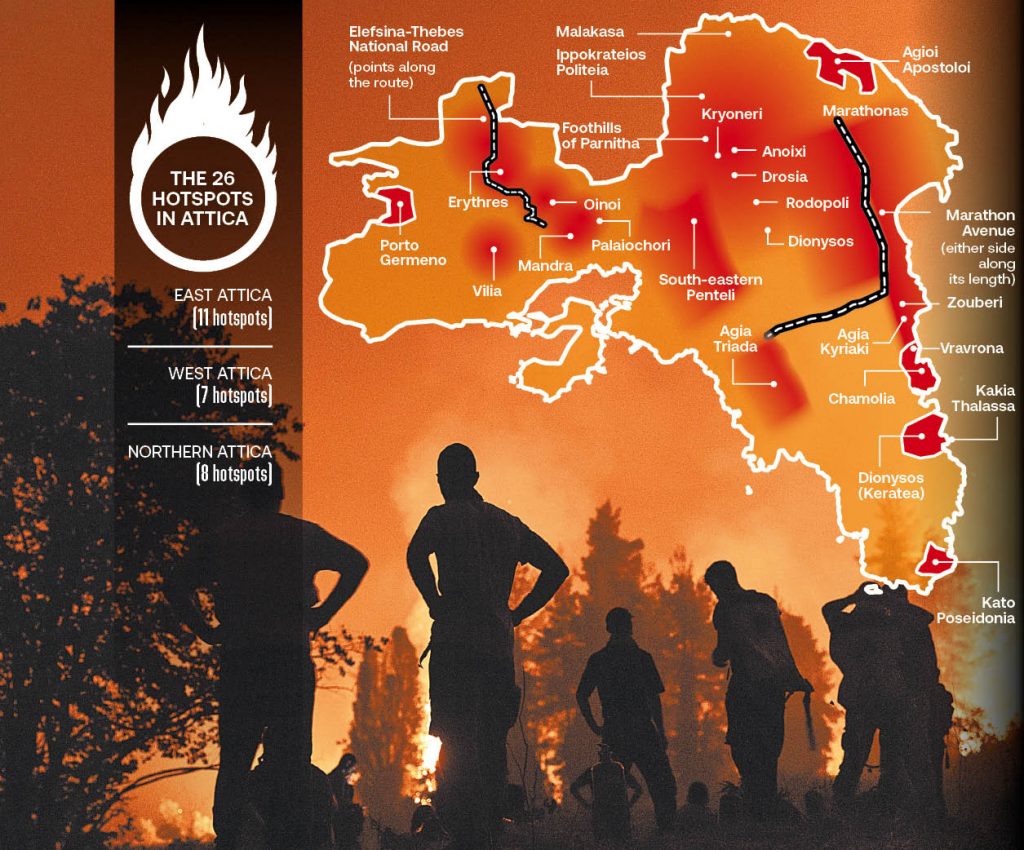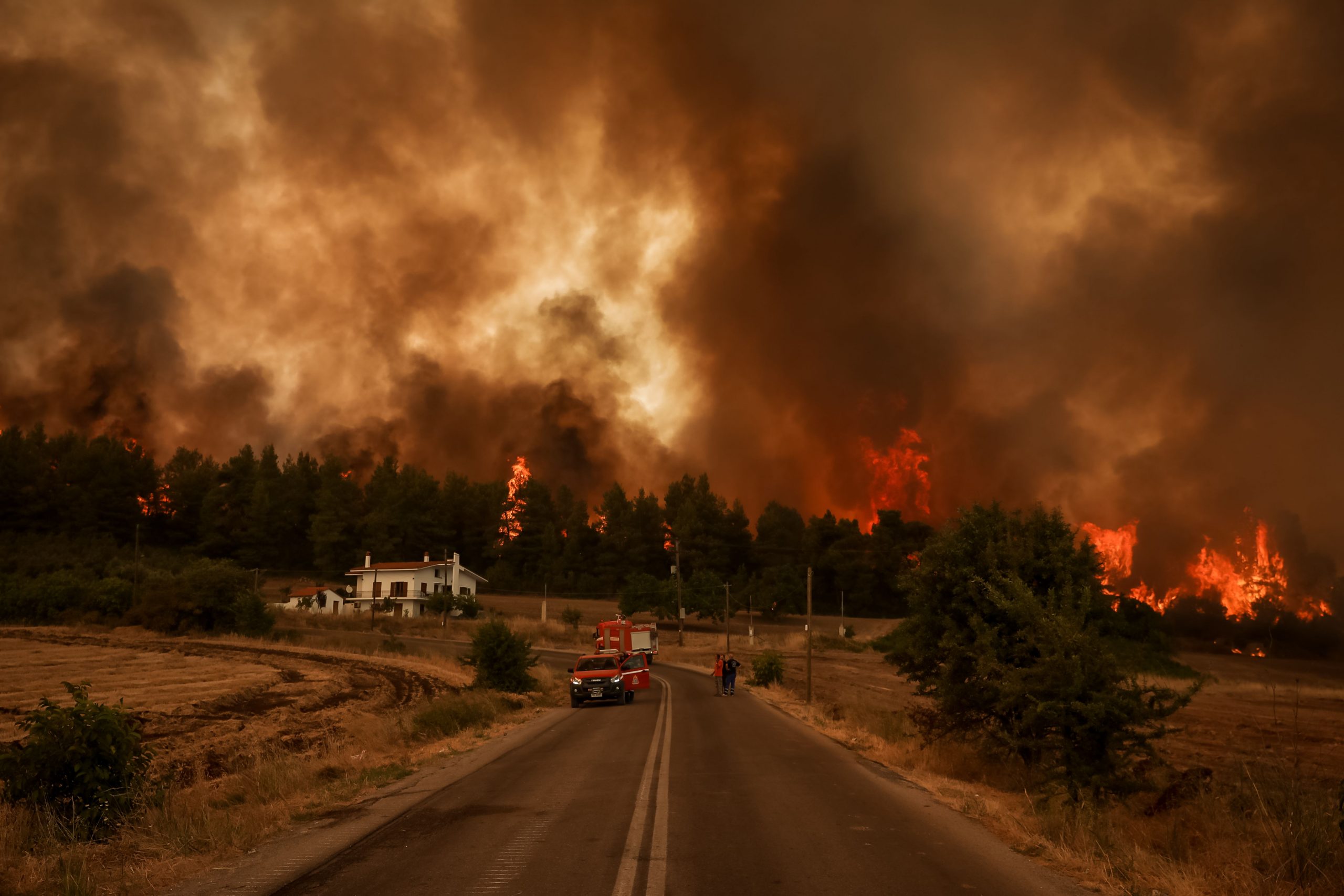At least 170,000 hectares of woodland were reduced to ashes by the wildfires which ravaged Greece in 2023, earning the country a sad first place among its 20 Mediterranean neighbors in terms of areas consigned to the flames. The most devastating forest fires in 16 years also left 28 people dead in their wake. The figures are especially worrying for long-suffering Attica, whose few remaining green lungs were badly hit. In fact, the region has lost 33% of its forested areas to fire over the last seven years.
According to data from the Ministry of the Environment and Energy and the Hellenic Fire Service, together with accounts which residents of wildfire hotspots shared with TO BHMA, at least 26 areas in Attica can be described as “ticking time bombs” with immediate action required to mitigate the fire hazards. According to the Ministry, most of the high-risk areas are in East Attica, although the pins on the “red-alert map” continue to spread.
East of Penteli

Speaking to TO BHMA, the forestry expert, former Director of Research at the Institute of Mediterranean Forest Ecosystems and former President of the Parnitha National Park Management Agency, Giorgos Karetsos, sounds the alarm for the areas east of Mount Penteli. “We’re talking about the entire Penteli coastline and areas south-east of the mountain. We see a very high degree of building—both legal and illegal—in the forest to the right and left of Marathon.” Vravrona, Kakia Thalassa, Chamolia, Zouberi, Agioi Apostoloi, Kato Poseidonia, Dionysos (Keratea), Agia Kyriaki and Agia Triada are some of the settlements on high alert.
“In the wider Parnitha area, the settlement of Ippokrateios Politeia, which recently paid the price, remains on the high-risk list. At the same time, there are high-risk areas in West Attica, too, where a major fire began in Kineta in 2018, while the situation is similar in the mountains. The problem is exacerbated by illegal building and construction within the forests. For the most part, of course, we are talking about small plots on which people have illegally built homes or holiday homes on public-owned forest land. This is the case between Mandra and Erythres, where thousands of houses have been built in wooded areas on both sides of the major road axes.”
The experts have repeatedly stressed that managing these mixed zones in which forest co-exists with homes that were built in settlements for which no planning was in place has the greatest potential for avoiding loss of life and saving property.
The danger wildfires pose to forest ecosystems is nothing new: it existed in the past and will continue to exist in the future. And this is mainly due to the activities that take place within them. As the data from the competent research bodies reveal, building in or near forests adds to the explosive cocktail of factors which, under certain circumstances, could lead to new tragedies. “In this case, of course, it’s not the forest’s fault, it’s our own mentality and lack of serious planning.”
Forest management and prevention
At this point, one has every right to ask: To what extent is the prevention plan being implemented? George Karetsos has the answer: “The Forest Service has implemented its anti-nero program. This is covered by the Recovery Fund via the Hellenic Republic’s Asset Development Fund (HRADF), which funds clean-up activities along roads, etc. However, the issue is that not even this is being done with proper planning. For example, there has been over-intervention in protected areas.”
According to the expert, forest ecosystem management has not been implemented for many years in those forests which have no “economic impact.” “If we exclude Macedonia, Thrace and the mountainous parts of the Peloponnese, where the forests are managed for timber harvesting, there is no forest management in the rest of the country.”
It should also be noted that forest fires were significantly fewer in number and smaller in size in the past, due to activities—and grazing, in particular—which removed excess biomass and cut down the amount of flammable matter. These areas also served as firebreaks, but they have been abandoned and the forest area is now unbroken. So, once a fire starts, there is nowhere where it can be stopped or contained so firefighters can intervene. Hence the recent phenomenon of mega-fires.
“We know where the high-risk areas are”
Focusing on the ticking time-bombs in Attica, the Director General of the Ministry of Environment and Energy’s Directory of Forests and Forest Environment, Evangelos Goudoufas, confirms that the Ministry has drawn up the requisite prevention plans in cooperation with the ministries of Climate Crisis and Civil Protection and the Hellenic Fire Service. “I am mainly referring to the cleaning up of forest ecosystems, the removal of excess flammable material, the maintaining of firebreaks, and so on. All of this is happening and it is happening fast.”
As he notes, around 32 wildfire hotspots were listed initially around Attica: “We know where the high-risk areas are, and we are intervening there. But there are also areas where municipalities and local authorities have to make interventions of their own. For example, there are children’s camps in East Attica where those responsible have to install fire extinguishing systems and clean up the areas.”
However, according to Evangelos Goudoufas, the understaffing of Greece’s forestry services is a significant “thorn” in the side of prevention. “No new appointments have been made to the nation’s forestry services since 2001, apart from a handful in 2005, so we have been 23 years now without new staff.”



